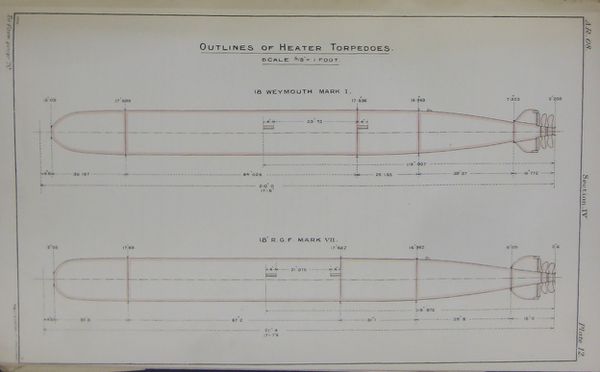|
|
| Line 7: |
Line 7: |
| In 1908-09, twenty S.L. units were ordered.{{ARTS1908|p. 7}} | | In 1908-09, twenty S.L. units were ordered.{{ARTS1908|p. 7}} |
|
| |
|
| In 1910, these were returned to Whitehead for alterations to engines, and were passing their range tests nicely. It seems that a delayed delivery was to commence.{{ARTS1910|p. v}} | | In 1909, these twenty were returned to Whitehead for "radical alterations in the engines", as they had been found not to be strong enough.{{ARTS1909|p. 13}} By 1910, the re-engined weapons were passing their range tests nicely.{{ARTS1910|p. v}} |
|
| |
|
| ===Particulars=== | | ===Particulars=== |
| Line 13: |
Line 13: |
|
| |
|
| Its overall length including 4.5-in long pistol was 17 feet, 6 inches (see Plate).{{ARTS1908|p. 18}} | | Its overall length including 4.5-in long pistol was 17 feet, 6 inches (see Plate).{{ARTS1908|p. 18}} |
| <!--
| |
| The final design's characteristics are detailed in the ''Annual Report of the Torpedo School, 1901''.{{ARTS1901|pp. 36-7}}
| |
| The construction was very similar in materials to the 14-in Mark IX torpedo.
| |
|
| |
| * Diameter: 17.71 inches
| |
| * Length: 16 feet, 7.4 inches
| |
| * Weight with pistol, without air: 1,156 pounds
| |
| * Metacentric height: at least .575 inches
| |
| * C.G. distance from tip of shaft, no air: 114.175 inches
| |
| * C.G. distance from tip of shaft, 60 pounds air: 114.35 inches
| |
| * Warhead: 200 pounds wet guncotton
| |
| It carried a charge of 170 pounds, 15 ounces – the same as in the [[18-in R.G.F. Mark III Torpedo|Mark III torpedo]].
| |
|
| |
| It had a Brotherhood engine of 3.25x3 inches.
| |
|
| |
| Mean pitch of propellors was 40 inches. When charged with air, the torpedo must pass through a gauge 9 inches long and 17.725 inches internal diameter.
| |
|
| |
| With pistol and charged with 60 pounds of air was ballasted and adjusted to float horizontally and upright in salt water at a density of 1.026 and 60 degree temperature. In fresh water, with pistol and no air, it had a buoyancy of 31 pounds.
| |
|
| |
| The proof and passing tests were six runs when charged to 1,350 psi:
| |
| * two runs from a submerged frame at target 800 yards distant
| |
| * two runs from an A.W. tube at least four feet above the water at a target 400 yards away
| |
| * one run above water at target 800 yards away
| |
| * one run from submerged frame at target 800 yards away
| |
|
| |
| The limits of deviation permitted were:
| |
| * lateral deviation from the submerged frame must be less than 12 yards either way throughout run
| |
| * from A.W. tube, lateral deviation of 8 yards at 400 yards or 24 yards at 600 yards
| |
| * deviation from set depth not to exceed +/- 18 inches
| |
|
| |
| The speeds required were:
| |
| * not less than 30 knots to 600 yards and 29 knots to 800 yards in 60 degrees and warmer
| |
| * not less than 29.5 knots to 600 yards and 28.5 to 800 yards in 50-60 degrees
| |
| * at least 29 knots to 600 yards and 28 knots to 800 yards in water colder than 50 degrees
| |
|
| |
| Endurance was tested in just one torpedo in a batch of twenty, after passing the above tests:
| |
| # make six short runs from above water gun 10 feet or more above water
| |
| # be fired from submerged frame and pass within 14 yards of target at 800 yards
| |
| # it must then "shew no signs of weakness or distortion"
| |
| -->
| |
|
| |
|
| ==Footnotes== | | ==Footnotes== |

Short 18-in Torpedoes, 1890[1] 
18-in Weymouth Mark I Torpedo[2] The 18-in Weymouth Mark I Torpedo was a heater torpedo built by Whitehead and ordered in small quantity in 1908-09.[3]
Development and History
In 1908-09, twenty S.L. units were ordered.[4]
In 1909, these twenty were returned to Whitehead for "radical alterations in the engines", as they had been found not to be strong enough.[5] By 1910, the re-engined weapons were passing their range tests nicely.[6]
Particulars
The warhead contained 161.75 pounds dry guncotton which weighed 198 pounds with 22.5 parts moisture.[7]
Its overall length including 4.5-in long pistol was 17 feet, 6 inches (see Plate).[8]
- ↑ Annual Report of the Torpedo School, 1909. Plate 2.
- ↑ Annual Report of the Torpedo School, 1908. Plate 12.
- ↑ Annual Report of the Torpedo School, 1908. p. 7.
- ↑ Annual Report of the Torpedo School, 1908. p. 7.
- ↑ Annual Report of the Torpedo School, 1909. p. 13.
- ↑ Annual Report of the Torpedo School, 1910. p. v.
- ↑ Annual Report of the Torpedo School, 1908. p. 10.
- ↑ Annual Report of the Torpedo School, 1908. p. 18.
Bibliography
See Also

